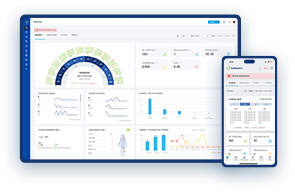
Smart Wearables: Advancing Safety in the Workplace
Wearable technologies have been gaining popularity in recent years, and their applications in safety management are becoming increasingly important. Wearable technologies are electronic devices that are worn on the body, typically incorporating sensors and wireless communication capabilities. These devices are designed to collect and transmit data, and they have the potential to enhance safety in various industries.
Examples of Wearable Technologies in Safety Management:
There are several types of wearable technologies used in safety management. Here are a few examples:
Personal Protective Equipment (PPE): PPE includes equipment such as hard hats, safety glasses, gloves, and respirators that are worn to protect workers from workplace hazards. With the integration of technology, PPE is becoming more advanced and capable of detecting and alerting workers to potential hazards.
Smartwatches and Fitness Trackers: Smartwatches and fitness trackers are devices worn on the wrist that track physical activity and provide data on health and wellness. In safety management, these devices can be used to monitor workers’ heart rates, activity levels, and fatigue to prevent accidents and injuries.
Smart Glasses: Smart glasses are equipped with cameras, microphones, and displays that provide workers with real-time information and hands-free communication. They can be used to overlay digital information onto the real world, such as displaying instructions, schematics, or maps.
Augmented Reality (AR) Devices: AR devices are wearable devices that superimpose digital information onto the physical world. In safety management, AR devices can provide workers with real-time information about their surroundings, such as identifying hazardous areas and providing alerts.
Related read: Our listing of the best Health and Safety Software.
Advantages of Using Wearable Technologies in Safety Management:
Wearable technologies offer numerous advantages in safety management, including the following:
Increased Safety and Reduced Risks: Wearable technologies can detect and alert workers to potential hazards in real-time, helping to prevent accidents and injuries. For example, PPE with embedded sensors can detect changes in temperature or hazardous gases, alerting workers to dangerous conditions.
Improved Employee Health and Well-being: Wearable technologies such as fitness trackers and smartwatches can monitor workers’ health and wellness, helping to prevent fatigue and stress-related illnesses. This, in turn, can improve employee engagement and productivity.
Increased Productivity: Wearable technologies can provide workers with real-time data and instructions, improving their efficiency and productivity. For example, smart glasses can provide workers with hands-free access to information and instructions, freeing up their hands for tasks.
Cost Savings: Wearable technologies can reduce costs associated with accidents and injuries by detecting and preventing them before they occur. This can also lead to reduced insurance costs and improved workplace efficiency.
According to a report by Grand View Research, the global market for wearable technologies in safety management is expected to grow significantly in the coming years, with a projected compound annual growth rate of 21.5% from 2021 to 2028. This growth is driven by the increasing adoption of wearable technologies in various industries and the demand for improved safety and efficiency.
Applications of Wearable Technologies in Safety Management:
Wearable technologies have numerous applications in safety management, including:
Hazard Detection: Wearable technologies such as PPE with embedded sensors can detect and alert workers to potential hazards in real-time, helping to prevent accidents and injuries. For example, gas sensors embedded in respirators can detect hazardous gases in the air, alerting workers to dangerous conditions.
Injury Prevention: Wearable technologies such as fitness trackers and smartwatches can monitor workers’ physical activity levels and fatigue, helping to prevent injuries caused by overexertion. Wearable alarms and alerts can also be used to notify workers of potential hazards, such as a vibrating wristband that alerts workers to an approaching vehicle.
Real-time Monitoring: Wearable technologies such as smart glasses and AR devices can provide workers with real-time information and instructions, improving their efficiency and productivity. For example, a worker wearing smart glasses can receive hands-free access to information and instructions, freeing up their hands for tasks.
Emergency Response: Wearable technologies can be used in emergency situations to quickly locate workers and provide them with assistance. For example, a GPS-enabled smartwatch can help locate a worker in distress, while a wearable alarm can alert emergency responders to a worker’s location.
Challenges in Implementing Wearable Technologies:
While wearable technologies have numerous benefits in safety management, there are also challenges to their implementation, including:
Cost: One of the biggest challenges in implementing wearable technologies in safety management is the cost. High-end devices such as smart glasses and AR devices can be expensive, making it difficult for some companies to justify the expense.
Privacy Concerns: Wearable technologies collect large amounts of data, including personal health and activity information. This data must be kept secure and private to protect workers’ rights. Companies must have strict policies and procedures in place to protect employee privacy.
Data Security: Wearable technologies can be vulnerable to hacking, making data security a critical concern. Companies must ensure that data collected by wearable devices is encrypted, and that all devices are updated with the latest security patches.
Employee Acceptance: Some employees may be resistant to wearing wearable technologies, especially if they perceive them as intrusive or as a potential invasion of privacy. Companies must address these concerns and work with employees to ensure their comfort and acceptance of the technology.
According to a report by McKinsey, successful implementation of wearable technologies in the workplace requires companies to carefully balance the benefits with the potential risks. Companies must have a clear understanding of the goals of their safety management program and ensure that the wearable technology they choose aligns with those goals. They must also establish clear policies and procedures for the use of wearable technologies, including training and ongoing monitoring of employee acceptance and satisfaction.
Future of Wearable Technologies in Safety Management:
As wearable technologies continue to advance, the future of safety management is expected to become even more sophisticated. Here are some potential developments that could shape the future of wearable technologies in safety management:
Advancements in Technology: The continued development of wearable technologies, including sensors and data analytics, will lead to more accurate and efficient safety monitoring. Wearable devices will become even more lightweight, durable, and capable of collecting data in real-time, providing workers with real-time feedback and alerts.
New Applications: Wearable technologies are already being used in a variety of safety applications, but new uses are constantly being developed. For example, wearable devices could be used to monitor fatigue levels, detect the presence of hazardous gases, or provide real-time feedback on safe lifting techniques.
Improved Safety Standards: Wearable technologies are helping companies to meet safety standards and regulations by providing real-time monitoring and feedback. As safety standards become more stringent, wearable technologies will play an even more important role in safety management.
Integration with Other Technologies: Wearable technologies will become increasingly integrated with other safety technologies such as drones, robots, and automated vehicles, providing a comprehensive safety management system.
The future of wearable technologies in safety management looks bright, with advancements in technology, new applications, and improved safety standards. Wearable technologies will continue to play an important role in safety management by providing real-time monitoring, feedback, and alerts. As safety standards become more stringent, wearable technologies will become even more essential for companies looking to protect their workers and meet safety regulations.

Ramesh Nair is the Founder and Principal Partner of Niyati Technologies, the company behind Safetymint.
He’s a dedicated advocate for workplace safety. Ramesh firmly believes that every individual deserves to return home safely after a day’s work. Safetymint, the innovative safety management software, emerged from this conviction. It’s a platform designed to streamline safety management, empower safety professionals, and enhance safety in workplaces.
Through his blog, Ramesh shares insights, best practices, and innovative solutions for workplace safety. Visit his social media profiles to follow him for regular updates.




